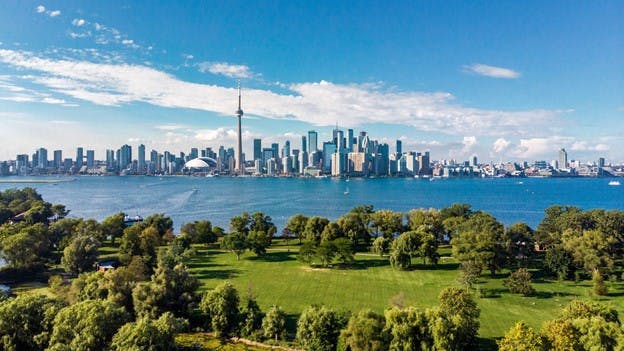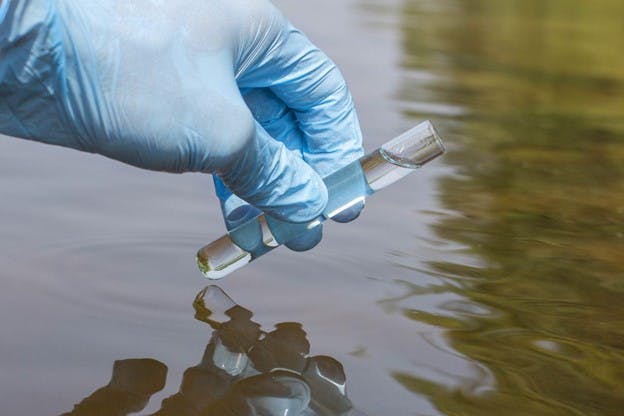February 2023
Everything You Need to Know About Toronto Water Quality
In-home expert installation available
Enter your zip code to see if we're in your area
Pressed against the coast of Lake Ontario, Toronto is one of the most unique cities in the world. It's a concrete jungle that has over 10 million trees. There are over 200 ethnicities represented among its nearly three million people — a population that makes it Canada’s largest city and the fourth largest in North America. In fact, about 25% of Canada’s entire population lives within 160 kilometers of Toronto and only half of those people were born in Canada.
While Toronto is already recognized as the most multicultural city in the world, the population of the Greater Toronto Area (GTA) is set to reach over 9 million people by 2036. With so many people from all over the world calling this great Canadian city home, it's important for the city of Toronto water quality standards to be very high.
In this guide, we’ll tell you the good, bad, and everything else there is to know about the drinking water systems in Toronto.
The Dirty Truth About Toronto Water Quality
If you live in Toronto, consider a water filter due to lead (pipes in older homes), E. coli, disinfection byproducts, and nitrates. HomeWater’s products can help improve the water quality in your home.
Explore our:
Where Does Toronto Water Come From and What Is the Water Treatment Process?
The province of Ontario has over 250,000 lakes, rivers, and streams, but its capital city of Toronto’s only water source is Lake Ontario.
Through several submerged intake pipes built 1 to 5 kilometers off shore, water is pulled from the great lake into a series of pipes that filter the water with chemicals and other methods.
Once many of the impurities are pulled out, the clear water that’s left reaches one of four different water treatment plants in the city. From there the water is brought up to the City of Toronto water quality standards set by the Ministry of the Environment, Conservation and Parks, by adding chlorine, fluoride, ammonia, and phosphoric acid.
Each chemical additive added to the water supply has a purpose.
- Chlorine is a disinfectant that kills illness-causing microorganisms like bacteria, parasites, viruses, and algae. These living contaminants could pose immediate risk to Toronto public health.
- Ammonia is added to stabilize the chlorine and ensure it acts consistently throughout the water supply.
- Fluoride is added to strengthen teeth and reduce the risk of cavities for all Torontonians.
- Phosphoric acid is added for corrosion control of the pipes used for water distribution throughout the city. Many pipes still in use contain lead. The phosphoric acid coats the pipes in an attempt to keep the lead in the pipes and out of your drinking water.
Once all of that is added, the now high-quality lake water makes its way toward a network of pumps, pressure stations, and holding tanks before ultimately becoming Toronto’s tap water.
How Often Is Toronto Water Tested?
To ensure Toronto water quality stays high, drinking water samples are taken and tested every six hours by Toronto Water’s lab.
They also conduct over 20,000 tests inside water treatment plants each year and they run 15,000 bacteriological assessments on samples collected from their water distribution system annually. All told, this is over 41,000 water tests each year.
Is It Safe to Drink Tap Water in Toronto?
Tap water in Toronto is considered safe to drink by Canadian authorities based on minimum quality standards for the contaminants they measure.
For many contaminants there are differences of opinion as to what is a safe level. Some contaminants are allowed in Canada but banned in Europe, for instance. It’s also worth mentioning that recommendations of safe levels of exposure to different contaminants are always changing as more research is done. This just means the levels of something that are considered safe today could be thought of as unsafe tomorrow.
Other contaminants, like microplastics, aren’t even tested for, simply because the technology isn’t there to test for it. Since it's unable to be tested for, they’re also unable to regulate it. Therefore the water is deemed to be safe regardless of microplastic concentration levels.
While you certainly don’t want to find out your water is over legal levels in anything, legal doesn’t always mean safe.
Is the City of Toronto Water Quality Good?
Generally, yes but not always.
The GTA gets its drinking water from Lake Ontario, which is a surface water system. Surface water systems are more susceptible to pollution than groundwater. This is often shown to be true in Lake Ontario where Marie Curtis and Sunnyside beaches are now using AI models to try to predict the days the water will be unfit for swimming due to very high E. coli levels.
A lot of the infrastructure in Toronto is almost a century old and isn’t equipped for the level of population now in the area. About 25% of the drainage pipes carry both storm water and sewage through the same pipe. When storms hit, sewers can overflow.
Rather than allowing the sewage to back up into homes and businesses, the system is designed to just dump everything in the lake. This includes human waste and everything else people and businesses flush down their toilets or send down their drains.
Wastewater treatment plants are also only equipped to remove certain contaminants. What’s not able to be removed will just be released back into Lake Ontario, where it will then end up in the drinking water later.
As you can see, Toronto water quality has room for improvement. Let’s take a look at some of the contaminants polluting Toronto water.
What’s Polluting Toronto Water?
All water has some impurities but some are more dangerous than others. This is just a short list of a few causing concern for some Toronto residents.
Lead
While the water is lead-free when it leaves the plant, old pipes on the way to your house or business can be made of lead. Houses that were built before the mid-1950s are particularly vulnerable since lead was used a lot back then in home plumbing.
Lead is a neurotoxin that can damage brain and nervous system development. The U.S. Environmental Protection Agency (EPA) says there is no safe level of lead in a child’s blood. If you have a child or pregnant person in your home, a test for lead in your water is a good idea.
If you do find lead, there’s a good chance it's in the pipes below your house, so a point-of-use filtration system like one that goes under your sink is best.
If you can’t buy a water filter for whatever reason, make sure to flush your system after periods of non-use before using the water for drinking or cooking. This can be done through anything that runs the tap for a few minutes, like taking a shower in the morning after a period of overnight non-use.
E. coli
E. coli is something Lake Ontario battles with constantly. Beaches are opened and closed to swimming based sometimes solely on the level of this bacteria in the water.
E. coli is linked to many different illnesses and infections including meningitis, septicemia, urinary tract infections, and intestinal infections. A recently discovered strain can cause severe disease and may be fatal in small children and elderly adults.
Disinfection Byproducts
While the amount of chlorine added to treat water is considered safe to drink, when chlorine and other chemical disinfectants react to organic matter, they create disinfectant byproducts that are considered carcinogens. The level of these byproducts can ebb and flow based on the amounts of chlorine used, the level of organic contaminants in the water, and the temperature of the water.
Nitrates
In the summer of 2022, the Lafontaine neighborhood – which is over 100km from Toronto and which gets its water from another source – had an advisory warning for elevated nitrate levels in the drinking water. Residents with infants under six months old were advised to use bottled water when preparing formula.
Elevated nitrate levels can cause methemoglobinemia or “blue baby syndrome” which is a condition that can turn the skin blue due to lack of oxygen in the blood.
Nitrate pollution can have many sources, but it’s often a product of nitrogen-based fertilizers and storm runoff.
Why Does Toronto Water Smell Earthy/Fishy?
While the water is considered safe to drink, in the late summer to early fall there is a higher presence of algae in Lake Ontario, which can cause the familiar unpleasant taste and smell.
Is Toronto Water Hard or Soft?
Toronto has surprisingly hard water. It's surprising because surface water systems like lakes usually are softer than groundwater systems. Hard water has a lot of calcium and magnesium mineral solids dissolved into it. While hard water isn’t harmful to ingest, those dissolved mineral solids can wreck your pipes and water using appliances.
Hard water also leaves bacteria-attracting soap scum on your surfaces, crust on your showerheads, mineral spots on your dishes, and wreaks havoc on your hair and skin.
If you’re a Torontonian, you’ll be surprised to see how much easier it is to keep a clean house once you add a water softener to your filtration system.
Is Toronto Water Good for Hair?
While Toronto has plenty of reasons for a night out, it doesn’t make it easy to look your best. Hard water minerals make it hard for soap to lather or fully rinse out of your hair. Meanwhile, the chlorine content in Toronto’s water dries out your hair and skin. A whole-house filtration system with an add-on salt-free water softener helps your hair to shine.
How Can You Get the Best Water Quality for Your Toronto Home?
With a population of over three million people, the city of Toronto water quality is very important to public health.
If you want the best-tasting, cleanest water possible, a HomeWater filtration system can help. It removes impurities like lead, chlorine, nitrates, and E. coli from your water and leaves you with only what you want in your glass.
Our HomeWater 4-Stage Whole House Filter protects every tap in your home. Add on a salt-free water softener if you want to say goodbye to soap scum and bad hair days.
If you’d rather an easier-to-install option, our HomeWater 4-Stage Under Counter Filter with reverse osmosis will get you complete protection in your kitchen, where it matters most. Be a friend to your hair and skin and pair it with a showerhead filter to reduce chlorine and hard water minerals from your shower too.
Related Articles
December 2022
Your Total Guide to Houston Water Quality
February 2023
The Important Facts About Chicago Water Quality
January 2023


